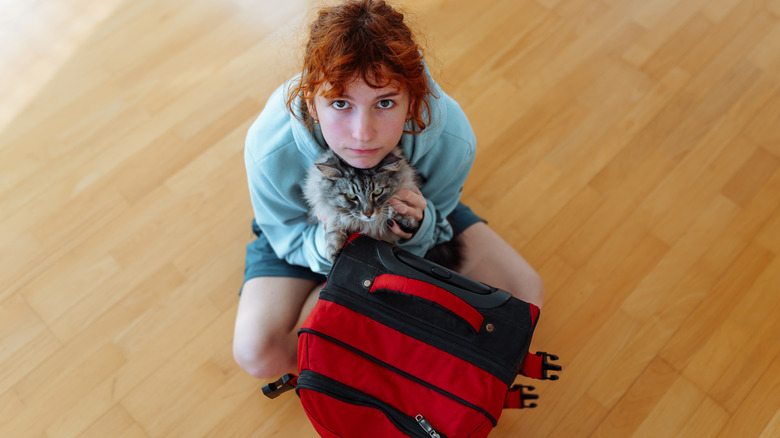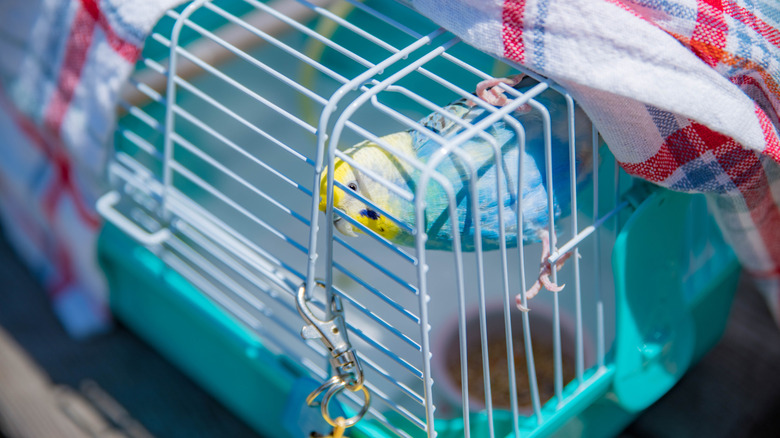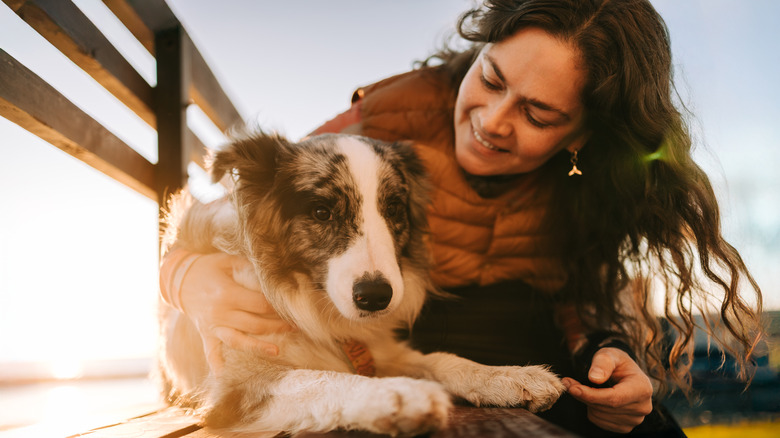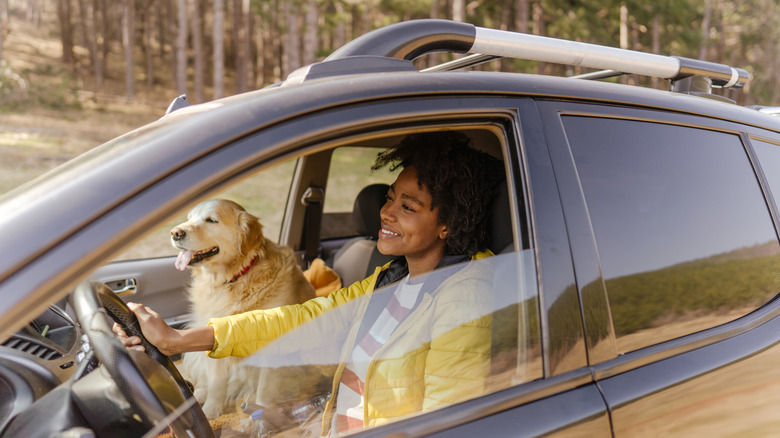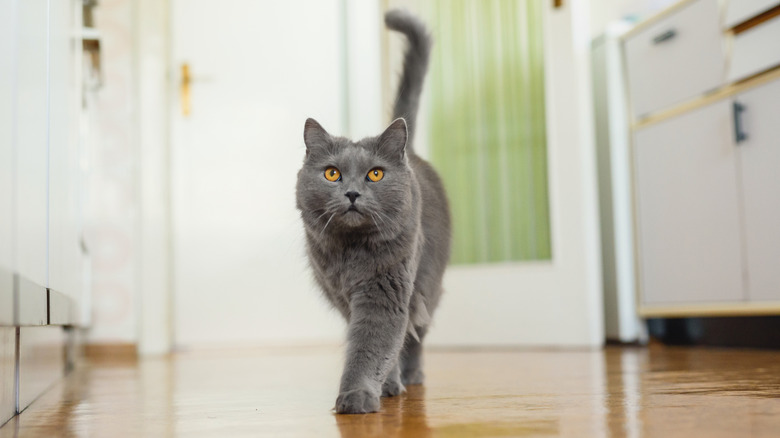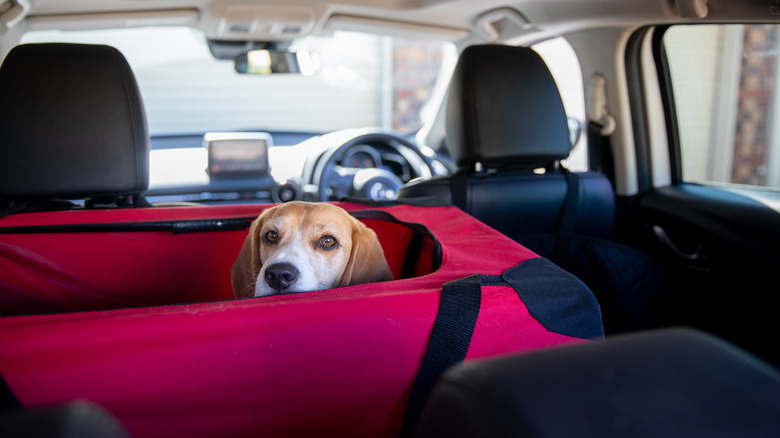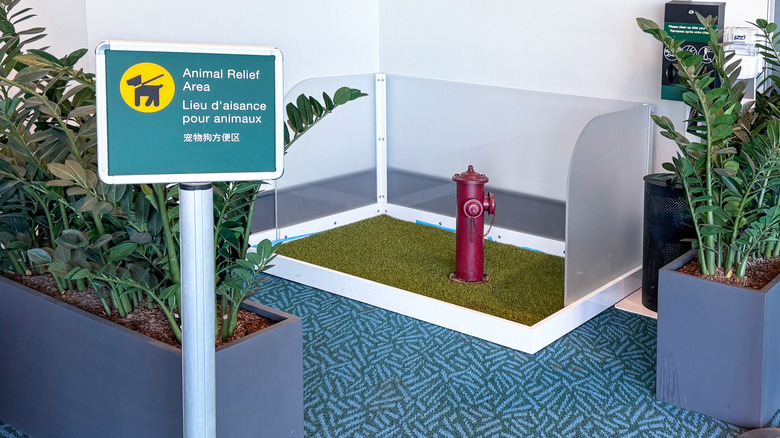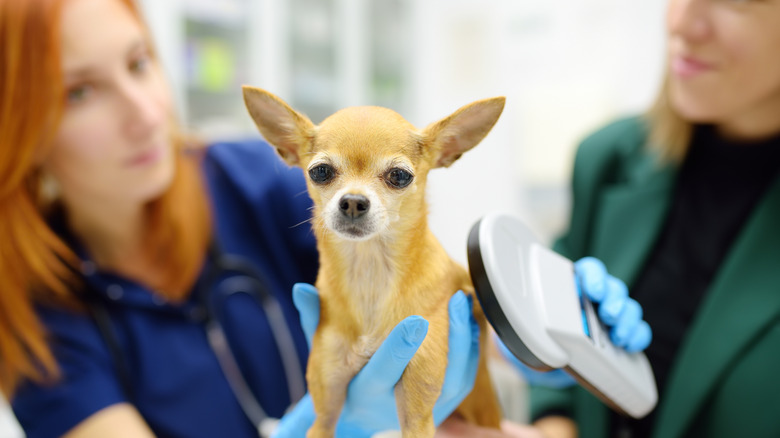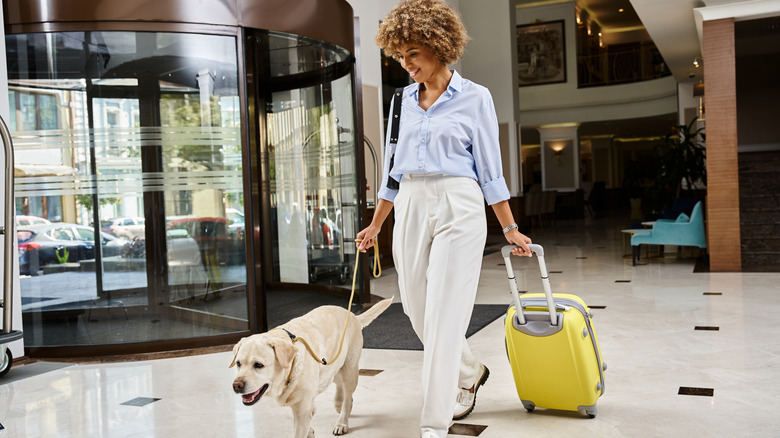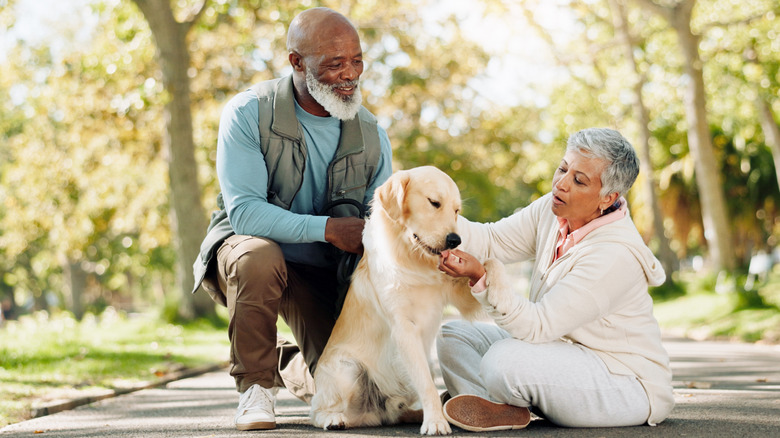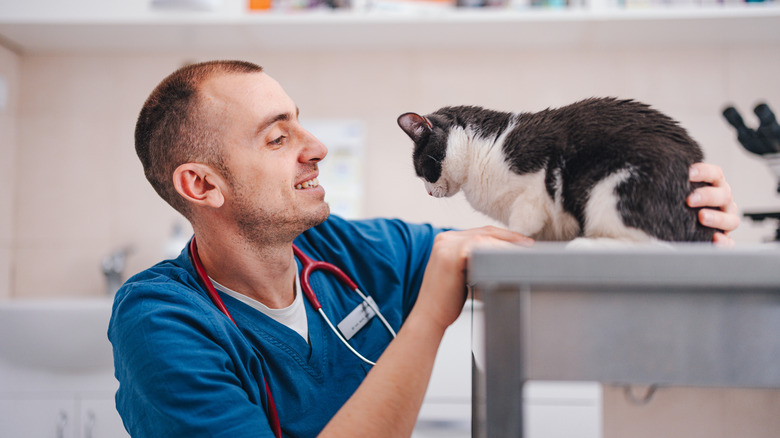14 Ways To Make Moving With A Pet So Much Easier
Moving house is challenging enough — but when you add pets into the mix, you're dealing with living, feeling creatures who probably have some strong opinions about the sudden upheaval all around them. Whether you're trying to herd cats who disappear at the first sign of moving boxes or dealing with uncontrolled chewing as a sign your dog is stressed out, taking the time to do a little advance planning, lay down some key supplies, and understand certain types of training and familiarization can help make moving with pets ever so much easier.
Have a go-bag for your pet
Anyone who's moved once or twice will know how important it is to have everyday essentials ready to grab during your move. This goes double for your pet, who has neither the thumbs nor (probably) the reasoning skills to pack for themselves. You can be the shining hero, however, if you add essential items for your pet in the "go-bag" you carry for yourself during the move — or perhaps give them a go-bag of their own.
For humans, go-bag essentials might include snacks, toiletries, medications, important papers, and a fresh change of clothes (or at least fresh socks and underwear). The travel essentials for your dog or other pets really aren't all that different: Think food and water bowls, plus the food and water of course; then add treats, a favorite blanket or bed, favorite toys, vaccination records, a leash and harness, kitty litter, and so on. Your goal is to include everything your pet needs in a typical day, plus reassuring comfort items and anything else you could imagine needing in an emergency.
For your pet's comfort, practice beforehand
Moving comes with new experiences for everybody. For you, that might mean the challenge of sorting through your accumulated life possessions and choosing what makes the cut to come with you to your new home. For your pet, the new experiences could mean anything from spending extended time in a carrier, going for long car rides, staying in a hotel, or even flying in an airplane. The more you can do to break these experiences down into their most basic components, and then give your pet an opportunity to get familiar with them in advance, the easier it'll be for both of you.
For example: If you're planning to drive your pet cross-country during a move, start by getting your pet used to the carrier you'll use while in the car. Leave the carrier out and open so your pet can explore it, and consider scattering a few treats inside as an extra lure. Once your pet goes into the carrier willingly, consider using it as a feeding station. There is no surer, faster way of building a positive association with the carrier than pairing it with food. Once your pet is comfortable inside the carrier, you can get it used to going for car rides. Start short and work up to longer rides/drives, with plenty of treats along the way.
Some of the other "skills" that might come in handy during a move include leash-training your dog (and sometimes, your cat), using a travel litter box or pee pads, meeting new people and pets, and simply exploring new environments. Even pet birds might enjoy an opportunity to get used to traveling in a travel cage since it might be substantially smaller than what it's used to at home.
Preserve your pet's routine
Our furry friends aren't just creatures of habit — they can be downright neurotic about it. The more of their normal routine you preserve throughout the move, the easier it'll be for them to adjust. As a bonus, because your pet's daily schedule is probably predicated to some degree on your own, preserving its sense of normalcy might bolster your comfort level, too.
If you're not sure how to structure your pet's routine during the move, try writing out the elements of your pet's life as you move through the day. When do you feed it, walk it, play with it, give it puzzle toys or other items for enrichment, or tuck it away for bed? That will give you the skeleton of a schedule to build your moving day(s) around, which doubles as a framework for building out the "new normal" routine once you've moved.
Take your pet with you
In a similar vein, unless you're employing a company that specializes in moving pets over long distances, the safest place for your pet to travel is with you. Not only will your pet be more comfortable that way, but you're also uniquely suited to "read" your pet's tells and identify what sort of support it needs during the move. For example, if you know your pup is prone to car sickness, you're already a step ahead in terms of identifying potential problems and, hopefully, dealing with them before they get too serious.
Identifying hurdles like motion sickness is exactly why it's so important to practice the elements of moving beforehand. If you wait until the big move to put your pet in the car, there might not be much you can do about the motion sickness. However, if you've tried it beforehand and spotted that your furry loved one is feeling ill, you'll have time to talk to your vet about anti-nausea medication or other remedies.
Consider all of the boxes
It's worth taking a minute to imagine what a sudden deluge of moving boxes might look like from your pet's point of view. We all know cats love boxes, but even they might be put off by their sudden appearance, or the disappearance of your belongings into them. Whatever kind of pet you have, there are two general approaches to keeping it comfortable around moving supplies. One is to turn the unfamiliar into something familiar, by collecting packing boxes early and giving your pet a chance to explore them. The other is to pack out of sight of your pets, which usually boils down to keeping your pets out of whatever room you're packing in on any given day.
Either way, remember that having lots of boxes around can create hiding opportunities for small pets like cats, so it's important to keep track of where your pets are and always check inside boxes before sealing them up. It's also very important to know when it's time to separate your pets from the chaos of moving for their own safety, no matter how comfortable they might seem in the moment.
Keep your pet close and contained
Few things are as heartbreaking as realizing that your best furry (or feathered, or scaled) friend has gone missing during a move. This especially applies to cats and dogs and free-ranging birds, all of whom are more likely to have the run of the house than, say, a lizard or a fish. Happily, there's a lot you can do to keep your pets from escaping or getting lost. The number one thing is to designate a safe, contained place for them — whether that means a separate room with a big sign on the door to keep it closed, or a large cage or crate that gives them enough room to be comfortable, but still keeps them safely contained.
If the moving or home environment is too chaotic for that to feel like a secure solution, consider boarding your pet with family or friends, or even at a professional boarding facility, for the most intense days of the move. Although none of you will enjoy being apart from each other, it's worth the peace of mind to know your pet won't panic and slip out the door in the middle of the chaos.
Pet-proof the new place, then let them explore
Just as it's a very smart move to keep your pets tucked in a safe, secure place during all the bustle of moving boxes and furniture out of your old home, it's equally important to ensure your pets have a safe place as people are hustling in and out of your new home. If you let them free-roam right away, even a pet who's previously stuck close to home might be so discomfited by the experience of moving that it goes into hiding, dashes through open doors, or even sets off in search of the familiar digs you just moved out of.
If you start with a designated "safe room" for your pet, full of familiar toys, beds, crates, and your pet's other belongings, it'll be able to become comfortable in that new space. Once the immediate hustle and bustle of moving in is over, consider expanding that comfort zone just a room or two at a time, keeping your pet well-supervised when it first explores any new area. Make sure you spend plenty of time with it during this settling-in period: After all, you're its emotional support human.
At the same time — or ideally, before you've moved your pet into the new place — you can set about making your new home pet-safe. Look out for known hazards like unsecured cleaning supplies that a nervous (or curious) chewer might get into, pest control items that might've been placed by the previous tenants or owners, the cords to window blinds, electrical cords your pet might chew, uncovered swimming pools, and anything else that might look tempting.
Consider crate training and research carriers beforehand
In a general sense, crate training a puppy or older dog — or even a cat — is all about giving your pet a designated safe place, which can be invaluable during the inevitable chaos of moving house. That crate training is especially useful when the designated safe place can travel with you. If the crate you've been using is too large or unwieldy to travel with, it's worth taking the time in advance to familiarize your pet with whatever travel carrier you've chosen to use instead.
If you're traveling by plane, train, or any other service that has regulations about which pet carriers are acceptable, put in some research beforehand to make sure you're choosing the right carrier for your pet. At a minimum, your pet should be able to stand up, sit down, and turn around inside the carrier comfortably, and there should be adequate ventilation. If your pet is coming in an airplane cabin with you, you might prefer a soft-sided carrier that's easier to tuck under the seat in front of you. If your pet is traveling via the pet hold in the belly of the plane, however, a hard-sided carrier is the standard.
A note about very large or tall dogs: Many airlines have limits on what size carrier they can accommodate in the pet hold, and owners of very large dogs sometimes struggle to find a travel carrier that's large enough for their dog but also small enough to be accepted on the plane. In this case, it's especially vital that you research the requirements ahead of time: If your pet can't fit into the hold of the plane, you can hire a professional pet-shipping service to get them to your new residence.
Plan for your pet's comfort
We humans are well-equipped to handle the stress of a long move, especially if it involves extremely hot or cold temperatures. We can add or remove clothing layers to stay comfortable, and have thumbs to operate an air conditioner or heater. Our pets, on the other hand — pun not intended — don't have those useful thumbs, and aren't able to speak out loud to tell us how they're feeling. They're also permanently zipped into their fur coats which, although they're great for some degree of temperature regulation, can only stretch so far to handle extreme heat or cold.
Due to this, it's on us to plan for the comfort, safety, and well-being of our furry friends while traveling. At a minimum, consider how you'll maintain a comfortable temperature for your pet on your chosen mode of travel, and make sure you give it sufficient breaks to relieve itself, eat, drink, and also play or at least stretch its legs. If you're making a cross-country drive, for example, you might want to break it up into shorter days so your older dog doesn't have to spend all day curled in his travel crate. Or, if you have a cat who you know will be miserable in cars or hotels no matter what, you might choose to do the drive in fewer, longer days, and get it over with as quickly as possible.
Make sure your pet is microchipped and the microchip is registered
If your pet does go missing, having it microchipped greatly increases your odds of being reunited. A 2014 study published in The Veterinary Journal found that pets with microchips were 21 times as likely to be reunited with their owners — as long as your microchip registry is kept current with your correct information. In most cases, this update can be done online via your pet's microchip manufacturing company website.
If you're not sure whether your dog, cat, or other pet is microchipped, now is the perfect time to double-check and, if necessary, get it done. As you move, don't forget the vital step of updating your pet's microchip registry with your new address and any other changes in contact information. The same applies to your pet's collar and tags.
Provide familiar comfort items before, during, and after the move
Your pets use their keen senses to make sense of the world around them — especially their sense of smell. With that in mind, it's a true kindness to pre-stock your new home with as many familiar comfort items as possible, to help your pet settle in and realize this is now "home." This can mean keeping your pet's favorite toys or bed ready and available during the move. This can also mean bringing pieces of your clothing that you've already worn — so the clothes smell like you — or maybe favorite blankets that smell like home.
After your move, items such as a cat tree or your dog's crate can also be familiar places to relax. The more familiar things you can have deployed around your new home before your pet even arrives, the easier it'll be for it to understand that it is, once again, exactly where it needs to be.
Choose pet-friendly accommodations if you need them
If your move takes more than one day, pet-friendly mobile apps or a few prudent online searches can help you track down pet-friendly accommodations. Whether you're staying in a hotel or a short-term rental, take a minute to make sure what sort of pets it accepts. Often, "pet-friendly" really means dog-friendly, and travelers with cats, birds, or other pets may find themselves out in the cold. Some locations may also have weight limits or pet number limits.
Similarly, make sure you understand any extra fees associated with bringing your pets, as well as any rules that apply. For example, some hotels forbid leaving your pets alone in the room, even if they're crated. While that's safest — because there's no chance of housekeeping accidentally letting them out — it also means that if you can't split your party and send someone out while another person stays with your pet, you might struggle to get necessities like grocery runs taken care of safely.
Consider your (new) local regulations regarding pets
Will your pet be on the right side of the law in your new home? There's only one way to be sure: Do some research beforehand. Some of the factors most likely to change from one locality to another include leash laws for dogs (and cats), and whether it's legal to let your pets outside unattended. Learning the lay of the (new) land ahead of time can help you save on fines, criminal penalties, and the social challenges that often come from violating local norms.
Some countries even ban certain dog breeds, especially bully breeds, or place them under strict regulation. For example, American bullies are banned from the United Kingdom, Turkey, and the United Arab Emirates, and their presence is heavily regulated in the Republic of Ireland, where they must be muzzled and kept on a fairly short leash when out in public. That's not the sort of thing that you'd want to find out after you've already moved.
Finally, as long as you have your research hat on, go ahead and do a little legwork to identify emergency vet clinics near your new home. It's hopefully unlikely that you'll need one but, if bad luck strikes and you do have a pet emergency after moving, you'll be glad you took the time to identify emergency services.
Talk to your vet before your move
Your veterinarian is an absolutely vital source of support throughout your pet's life, so make sure to stay in close contact with them before, during, and after your move. They can provide you with any paperwork you might need — including health certificates and vaccination records — along with preventive medications, suggestions to mitigate the stress of the move for your pet, and information about any new parasites or health conditions that might be an issue in your new home.
Depending on how your pet is handling the move, your veterinarian might also prescribe calming medications to make the relocation easier for everybody — and if you're moving too far away to stay with the same vet, they might be able to refer you to a veterinary clinic near your new home.
Moving can be stressful for you and your pets. Luckily, taking the time to research beforehand, setting up a positive, comforting environment before and after the move, and just giving your pets a little extra love and care can help ease the transition to a new space.

